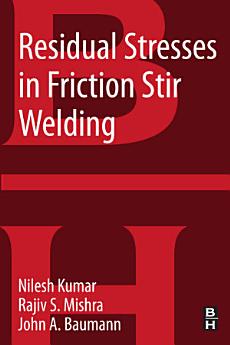Residual Stresses in Friction Stir Welding
Nov 2013 · Butterworth-Heinemann
Ebook
60
Pages
family_home
Eligible
info
reportRatings and reviews aren’t verified Learn More
About this ebook
This book describes the fundamentals of residual stresses in friction stir welding and reviews the data reported for various materials. Residual stresses produced during manufacturing processes lead to distortion of structures. It is critical to understand and mitigate residual stresses. From the onset of friction stir welding, claims have been made about the lower magnitude of residual stresses. The lower residual stresses are partly due to lower peak temperature and shorter time at temperature during friction stir welding. A review of residual stresses that result from the friction stir process and strategies to mitigate it have been presented. Friction stir welding can be combined with additional in-situ and ex-situ manufacturing steps to lower the final residual stresses. Modeling of residual stresses highlights the relationship between clamping constraint and development of distortion. For many applications, management of residual stresses can be critical for qualification of component/structure. - Reviews magnitude of residual stresses in various metals and alloys - Discusses mitigation strategies for residual stresses during friction stir welding - Covers fundamental origin of residual stresses and distortion
About the author
Nilesh. N. Kulkarni Ph.D. completed his M.E. (electronics and telecommunication) from All India Shri Shivaji Memorial Society's Institute of Information Technology, Pune. His areas of interests include biomedical signal and image processing, pattern recognition, and machine learning. Presently, he is working on biomedical signal processing applications. He is a member of IETE and IEI, India and a member of the IEEE.Prof. Rajiv Mishra (Ph.D. in Metallurgy from University of Sheffield) is a Regents Professor at the University of North Texas and founder of Optimus Alloys LLC. He is a Fellow of ASM International. He is a past-chair of the Structural Materials Division of TMS and served on the TMS Board of Directors (2013-16). He has authored/co-authored more than 450 papers in peer-reviewed journals and proceedings and is principal inventor of four U.S. patents. His current Google Scholar h-index is 95 and his papers have been cited more than 43000 times. He has co-authored three books; (1) Friction Stir Welding and Processing, (2) Metallurgy and Design of Alloys with Hierarchical Microstructures, (3) High Entropy Materials: Processing, Properties, and Applications. He has edited or co-edited fifteen TMS conference proceedings. He was an associate editor of Journal of Materials Processing Technology and is the founding editor of a short book series on Friction Stir Welding and Processing published by Elsevier and has co-authored seven short books in this series. He is a recipient of TMS-SMD Distinguished Scientist Award in 2020 and TMS-MPMD Distinguished Scientist Award in 2024. He is an adjunct professor in the department of Materials Science and Engineering at North Carolina State University. Most recently, he has founded Optimus Alloys LLC for commercialization of research efforts and serves as the Chief Scientific Advisor. Optimus Alloys is focused on process-specific alloy design for additive manufacturing of high-performance components.
Rate this ebook
Tell us what you think.
Reading information
Smartphones and tablets
Install the Google Play Books app for Android and iPad/iPhone. It syncs automatically with your account and allows you to read online or offline wherever you are.
Laptops and computers
You can listen to audiobooks purchased on Google Play using your computer's web browser.
eReaders and other devices
To read on e-ink devices like Kobo eReaders, you'll need to download a file and transfer it to your device. Follow the detailed Help Center instructions to transfer the files to supported eReaders.






